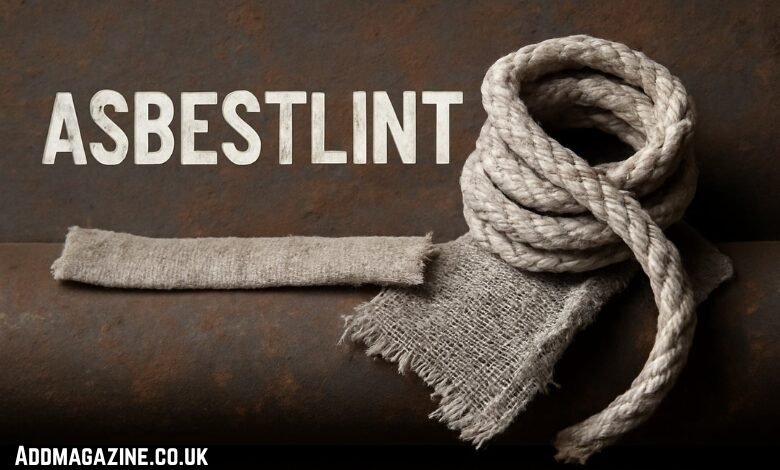When working on home renovations, dealing with old buildings, or even browsing through historical documents, you may come across a term that seems unfamiliar: asbestlint. While it might sound like a unique product or a modern construction material, it is essential to clear the confusion and understand what this term truly refers to.
In this blog post, we will break down the meaning of asbestlint, its historical usage, and the dangers it poses, particularly in the context of asbestos-related health risks. We will also discuss how it is connected to asbestos, an element that was once regarded as a miracle material but is now known for its severe health consequences.
What is Asbestlint?
The term asbestlint is not commonly used in modern-day English construction or materials vocabulary. Instead, it is most likely a linguistic blend or a mistranslation of terms from German, Dutch, or Scandinavian languages, with asbest meaning asbestos and lint referring to rope, string, or tape.
In other words, asbestlint is a way of describing asbestos-containing materials in rope, string, or tape form. These materials were once commonly used in various industrial and residential applications, particularly in buildings constructed before the 1980s.
The term itself provides significant clues. Let’s break it down:
- Asbest: The word for asbestos in German, Dutch, and Scandinavian languages.
- Lint: Translates to “rope,” “tape,” “string,” or “wick” in these languages.
Thus, asbestlint is simply a term for asbestos-based textiles, often in the form of rope, tape, or cloth, that was used for insulation and protection.
The Rise of Asbestos in Construction
Asbestos, a naturally occurring mineral, was once widely hailed as a miracle material due to its exceptional properties. These included:
- Heat Resistance: Asbestos is highly resistant to heat, making it ideal for use in insulation around pipes, boilers, and furnaces.
- Fire Resistance: Its fire-retardant properties were used in a wide variety of applications, from flooring to roofing.
- Chemical Corrosion Resistance: Asbestos is highly resistant to many chemicals, which made it valuable in industrial and manufacturing settings.
- Durability: The material is strong, making it suitable for insulation, reinforcement, and even as a textile for rope and cloth.
In the early to mid-20th century, asbestos was widely used in construction and manufacturing due to these benefits. Asbestos products were used in a variety of forms, including insulation, ceiling tiles, flooring, brake pads, roofing materials, and even as textiles for ropes and tapes.
The woven or braided asbestos textiles, often referred to in historical contexts as asbestlint, were particularly common in the industrial sector for use in gaskets, fireproofing, and insulation for pipes, boilers, and furnaces.
However, it was only after decades of use that the serious health risks of asbestos began to surface.
The Dangers of Asbestos
Asbestos has one fatal flaw: its microscopic fibers. These fibers are so small and lightweight that they can easily become airborne and be inhaled without the person even realizing it. Once inhaled, these fibers can become trapped in the lungs and remain there for years, causing irreparable damage over time.
Prolonged exposure to asbestos can lead to several life-threatening diseases, including:
- Asbestosis: A long-term lung condition that causes permanent scarring of the lung tissue, leading to breathing difficulties.
- Lung Cancer: Prolonged asbestos exposure is a proven contributor to the development of lung cancer, a severe respiratory disease.
- Mesothelioma: A rare and aggressive cancer that primarily affects the lining of the lungs and abdomen.
- Other Cancers: Asbestos has been associated with an increased risk of cancers affecting the larynx, ovaries, and several other organs.
The health risks associated with asbestos exposure were largely unknown until the 1970s. By that time, asbestos had already been widely used in countless products, including those used in homes, schools, and workplaces.
Asbestlint: A Hazardous Legacy
If you come across what appears to be old, frayed rope, tape, or cloth around pipes or old appliances, particularly in homes or buildings constructed before the 1980s, it is critical to exercise extreme caution. These materials could very well contain asbestos.
Over time, asbestos-containing materials degrade and become friable, meaning they can be easily crumbled by hand. When this happens, the asbestos fibers are released into the air, creating a significant health risk for anyone who breathes them in.
Old asbestos tape and insulation rope products were commonly used to wrap pipes, ducts, and other structures to prevent heat loss or fire hazards. These materials are highly susceptible to wear and tear, and their degradation can release harmful asbestos fibers.
Key Signs That You Might Encounter Asbestlint
- Age of the Building: Homes and buildings constructed before the 1980s are more likely to contain asbestos.
- Appearance of Materials: Asbestos-containing materials like tape or rope often have a fibrous texture and may be white or gray in color. Over time, they may become brittle and fray.
- Location of Materials: Asbestos textiles like asbestlint were often used in places with high heat, such as pipes, furnaces, boilers, and industrial machinery.
If you encounter these materials, do not attempt to touch or disturb them. The release of asbestos fibers into the air can be fatal, and disturbing these materials without proper safety precautions can be hazardous to your health.
How to Handle Asbestos Safely
If you suspect the presence of asbestos in your home or workplace, there are strict guidelines for handling and removal. These guidelines are designed to minimize exposure and protect individuals from harmful asbestos fibers.
Here are some safety steps to take:
- Do Not Disturb: If you see old asbestos materials, such as tape or rope, leave them undisturbed.
- Hire a Professional: Always hire a certified asbestos removal professional to inspect and remove asbestos-containing materials. These experts have the proper equipment and training to handle asbestos safely.
- Seal Off Areas: If asbestos materials must be removed, the area should be sealed off to prevent fibers from escaping into the air.
- Wear Protective Gear: Protective clothing, respiratory protection, and containment measures are essential when dealing with asbestos.
- Dispose of Asbestos Properly: Asbestos must be disposed of at a licensed disposal facility to prevent contamination.
Asbestos Removal Laws and Regulations
The dangers of asbestos have led to strict regulations and laws governing its removal and disposal. In many countries, including the United States, Canada, and European Union nations, asbestos removal is heavily regulated, and professionals must follow specific protocols.
In the U.S., for instance, the Environmental Protection Agency (EPA) enforces rules regarding the safe handling and removal of asbestos. Many states and localities also have their own regulations that govern the removal process. These rules are intended to minimize health risks associated with asbestos exposure and ensure that it is disposed of properly.
Conclusion
Asbestlint may not be a term you come across every day, but it refers to a critical aspect of asbestos use in the past: asbestos-based rope, tape, and textiles. While these materials were once considered revolutionary for their heat resistance and durability, the dangers they pose to human health are now well-documented and should not be underestimated.
If you encounter what you suspect is asbestos-containing material, such as asbestlint, in older buildings or appliances, it’s crucial to exercise caution. Always hire professional asbestos removal specialists to safely manage and remove these materials.
Remember, the safety of you and those around you should always be the top priority when dealing with potentially hazardous materials like asbestos.




